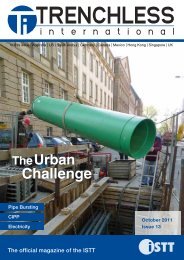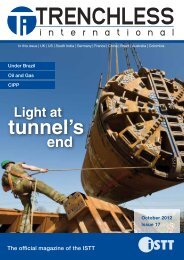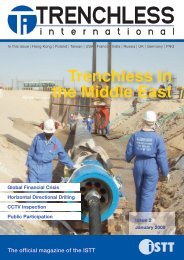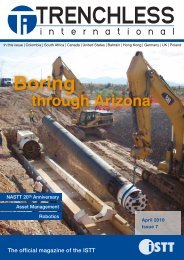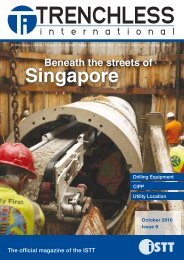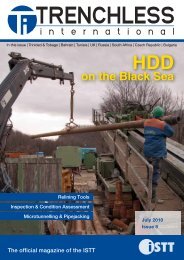North American Special - Trenchless International
North American Special - Trenchless International
North American Special - Trenchless International
You also want an ePaper? Increase the reach of your titles
YUMPU automatically turns print PDFs into web optimized ePapers that Google loves.
projects<br />
April 2009 - <strong>Trenchless</strong> <strong>International</strong><br />
Reconstructing pipes<br />
in Wajima City<br />
By Masatoshi Kasukawa, Komatsu. Translated by Kyoko Kondo<br />
In Wajima City, Noto Island Japan, an earthquake caused the destruction of more than 16 km of<br />
sewer and agricultural pipes. To restore the pipes, a new trenchless technique was applied – the<br />
IM-Rebirth method can crush and remove existing reinforced concrete pipes and install new pipes<br />
along the same trajectory.<br />
The IM-Rebirth solution successfully<br />
overcame some unexpected<br />
difficulties to reconstruct approximately<br />
1.2 km of sewer pipeline, the first pipeeating<br />
project of this scale to be carried<br />
out in Japan.<br />
The entrance of the Wajima city building.<br />
The flag says “Hang in there!” following the<br />
earthquake.<br />
The sewers to be reconstructed were<br />
located at the end of the downstream,<br />
immediately before the Monzenmachi<br />
wastewater management center. The<br />
pipeline was buried below National Route<br />
249 at a depth of 4.2 metres down to 6.3<br />
metres. The Hakkagawa River runs along<br />
the road and there were many cracks<br />
observed at the river wall. It was predicted<br />
that the whole area was affected from<br />
the ground deformation due to the earthquake.<br />
Many existing manholes had been<br />
dislocated due to the water pressure. The<br />
type of soil was water-bearing stratum,<br />
which seemed to have increased the<br />
warping of the ground. Even from above<br />
ground, it was clear that the sewers had<br />
suffered displacements.<br />
Outline of damaged pipes sagging.<br />
Choosing the right technology<br />
After considering the level of sagging<br />
and displacements, CIPP was deemed<br />
an inappropriate method to restore the<br />
sewers, therefore the choice was made<br />
to reconstruct the whole pipe. There were<br />
two options for reconstruction; open cut<br />
and trenchless. Open cut was rejected<br />
as the pipeline was too deep to excavate.<br />
Moreover, taking into account the ground<br />
water level and economic efficiency, the<br />
trenchless method was selected as the<br />
optimum solution. An alternative was to<br />
install a pipeline next to the damaged<br />
pipe using the standard microtunnelling<br />
method. However, microtunnelling needs<br />
disposal treatment of the existing sewers<br />
including removing manholes up to the 1.5<br />
metre level. Considering all of these factors<br />
the pipe eating method was selected.<br />
The types of existing sewers were;<br />
1. Humes pipe for open cut construction<br />
2. Humes pipe for microtunnelling construction<br />
– including stainless steel<br />
collar<br />
3. A Humes pipe as a casing pipe – PVC<br />
pipe of 200 mm diameter was placed<br />
inside.<br />
Pipe eating method A, from the current<br />
reconstruction method listed in the guideline<br />
issued by Japan Microtunnelling Association,<br />
was chosen to crush and remove the existing<br />
damaged pipeline (pictured).<br />
Reconstruction method<br />
The IM-Rebirth method<br />
The IM-Rebirth method is based on<br />
traditional machines, such as Slim-Ark<br />
TA50 and the Iron Mole series, which can<br />
excavate hard cobbles and rocks. The difference<br />
between these machines and the<br />
IM-Rebirth method is the cutting head with<br />
a special cutter, spiral or gear type, which<br />
can crush the existing reinforced concrete<br />
pipes and reinforcing steels bars. This<br />
method not only crushes the existing pipe<br />
but also removes the pieces. This results<br />
in a newly installed pipe. The cutter head<br />
can also crush railroad ties and stainless<br />
collar used between the pipes.<br />
The jacking head torque is high enough<br />
to crush the hard cobbles and rocks<br />
located around the pipes. The starting<br />
shaft can be very small. For pipe diameters<br />
of 250 mm up to 300 mm only a 2<br />
metre shaft is required, and for pipe diameters<br />
of 350 mm up to 500 mm a 2.5 metre<br />
shaft is required.<br />
A cutting head after the excavation test.<br />
Reconstruction methods from the<br />
Japan Microtunnelling Association<br />
Static crushing and jacking method<br />
Dynamic crushing and jacking method<br />
Rotating/ crushing and jacking method<br />
A type<br />
B type<br />
Pull-out and jacking method<br />
Scope of application<br />
Existing pipe diameter: up to 1000 mm<br />
Diameter of new pipe: 250 – 1,000 mm<br />
Total length: 150 metres – depending on condition<br />
Existing pipe type: hume pipe, (for open-cut , jacking pipe with SUS<br />
collar), clay, PVC, PE, FRP<br />
Ground conditions: standard soil, sand gravel, base rock layer<br />
Applications: same diameter to same diameter, reducing diameter,<br />
enlarging diameter, adjusting trajectory.<br />
Crashed pieces at the test excavation.<br />
The IM-Rebirth method was selected<br />
because of the cutter head's ability to<br />
crush reinforced pipes and SUS (stainless)<br />
collars. However, as the project<br />
progressed, it was revealed that a spacer<br />
of 5 mm thickness was used inside of<br />
the casing pipe for placing VU 200 mm.<br />
To negotiate this problem, an excavation<br />
test was carried out before the<br />
actual construction commenced. The test<br />
showed that although the jacking speed<br />
had slowed down greatly and the cutting<br />
face was abraded a little from the excavation,<br />
the machine can drive forward<br />
despite the presence of the spacer.<br />
Some parts of sewer were completely<br />
out of service and temporary bypassing<br />
was carried out. Several drives were<br />
progressing at the same time; therefore a<br />
well-planned bypassing was necessary.<br />
Bypassing of the current live sewers was<br />
carried out by using the proven technique<br />
for long-distance sewers called Mr. Autobypass.<br />
The Mr. Auto-bypass has working<br />
records of 17.5 km and out of this record,<br />
3 – 5 km were bypassed simultaneously<br />
while constructing several, mainly opencut<br />
drives.<br />
Shaft construction<br />
The existing manholes were damaged<br />
from liquefaction and needed to be<br />
replaced. Therefore, the spaces for replacing<br />
manholes were used as departing and<br />
arrival shafts. In 300 mm diameter pipes, a<br />
shaft diameter of 2 metres was used and<br />
for 350 – 400 mm pipes a shaft diameter<br />
of 2.5 metres was used, which contributed<br />
to reduced construction costs.<br />
Infilling existing pipes<br />
The existing pipes suffered displacement,<br />
sagging as well as some<br />
infiltration of waters and surrounding soils.<br />
It was anticipated that the area around<br />
the machine excavation could be a void<br />
and cave-ins might occur after the construction.<br />
To avoid this problem, infilling of<br />
existing pipes was carried out in order to<br />
prevent cave-ins. The filling material was<br />
a cement-mortar.<br />
Removal of pit-head<br />
The waterproofing equipment and sheet<br />
piles used for the first installation, buried<br />
in place, needed to be removed. The<br />
open-face jacking of 1,000 mm diameter<br />
was used to remove this equipment at the<br />
beginning of the drive and then removed<br />
manually.<br />
The cutter head<br />
The cutting head, equipped with the<br />
special cutter to crush reinforced pipes,<br />
progressed smoothly along the planned<br />
paths. At the peak, seven jacking machines<br />
were driving simultaneously. The crushed<br />
pipes, taken in by the jacking machine,<br />
consisted of materials such as reinforced<br />
steel bars, SUS collars, waterproofing<br />
rubbers and PVC pieces. Railway ties<br />
placed below the pipes were also found<br />
in small pieces. The most difficult section<br />
of excavating the 400 mm casing Humes<br />
pipe and 200 mm VU pipe plus spacers<br />
was carried out successfully, although the<br />
driving speed did not reach the planned<br />
rate. The discharged soil was treated as<br />
industrial waste since it contained steel<br />
pieces, concrete, VU and others.<br />
In total, 21 drives were carried out and<br />
there were no serious problems requiring<br />
the driving be halted. The special cutter<br />
equipped at the cutting face had some<br />
ablation from cutting spacers, but was<br />
able to continue the drive.<br />
The pipe eating [and jacking] method<br />
is normally used to replace aged pipes<br />
with new pipes. However, this construction<br />
was carried out to replace existing<br />
pipes damaged greatly from the earthquake.<br />
Many of the damaged pipes had<br />
suffered displacements and sagging and<br />
some sewers had lost function completely.<br />
Komatsu’s first pipe-replacing technology<br />
was achieved in 1995, the time of Great<br />
Hanshin-Awaji earthquake, proving that<br />
this method could be used for replacing<br />
pipes that have experienced large<br />
displacements. Smooth bypassing had<br />
also contributed a great deal in making<br />
the whole reconstruction successful.<br />
Above: Excavation test.<br />
Left: A spacer.<br />
projects<br />
April 2009 - <strong>Trenchless</strong> <strong>International</strong><br />
20<br />
21






